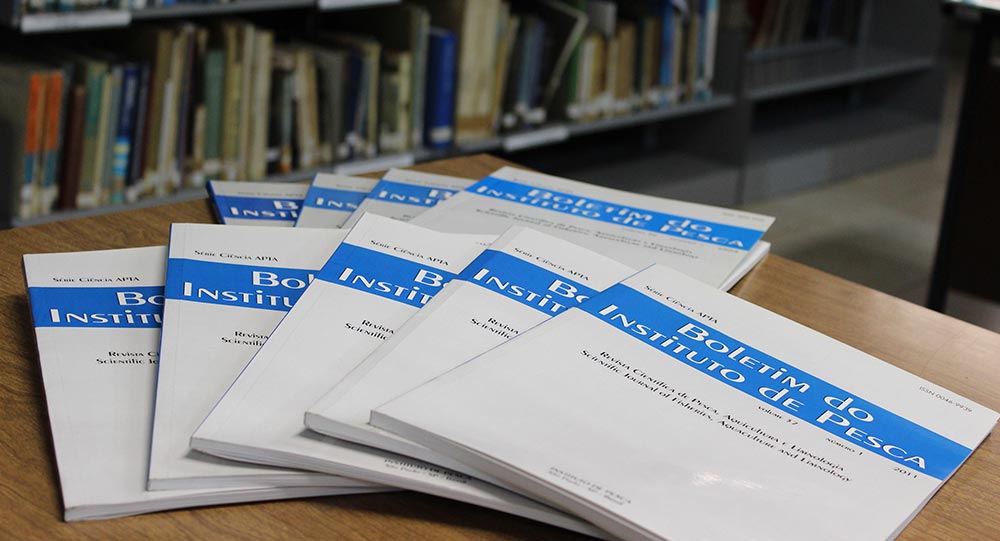Frequency of feeding for fingerlings of common carp
Keywords:
Cyprinus carpio, feed handling, fish farmAbstract
The best frequency of feeding for development of common carp fingerlings Cyprinus carpio was determined. Four hundred fish (4.88 ± 1.41 g and 6.72 ± 0.70 cm) were used, distributed in 20 tanks of 250 L each in completely randomized design, with four treatments and five replicates. The four feeding strategies adopted were: providing feed once (T1), twice (T2), three (T3) and four times daily (T4) at the same amount being fractionated as described. At the end of 45 days of experiment, it was carried out measurements of the final weight (FW), final length (FL), weight gain (WG), feed conversion (FC), specific growth rate (SGR) and survival (SR). It was evaluated the chemical composition of fish carcass: moisture (MT), crude protein (CP), lipids (LP) and ash (AS), and hematological analyzes were performed such as erythrocyte (ER), hemoglobin (HG) and hematocrit (HT). There were significant statistical differences (P<0.01) for FW, FL, WG and SGR. For FC and SR there were no statistical differences (P>0.01). For the chemical composition, the moisture, lipids and ash showed significant statistical differences (P>0.01), except for protein (P>0.01). The hematological composition was not influenced by the feed frequency; it was not observed significant statistical difference (P>0.01) of erythrocytes, hemoglobin and hematocrit among dietary treatments. For common carp fingerlings, the provision of ration four times daily provided better final weight, final length, weight gain and specific growth rate without causing changes in the composition and hematological parameters of the fish.
References
2013 Eugenol e benzocaína como anestésicos para juvenis de carpa comum (Cyprinus carpio).Revista Brasileira de Ciências Agrárias, 8(1): 163-167.
BARROS, M.M.; PEZZATO, L.E.; KLEEMANN, G.K.;HISANO, H.; ROSA, G.J.M. 2002 Níveis de vitamina C e ferro para tilápia do Nilo (Oreochromis niloticus). Revista Brasileira de Zootecnia, 31(6): 2149-2156.
BARROS, M.M.; RANZANI-PAIVA, M.J.T.; PEZZATO, L.E.; FALCON, D.R.; GUIMARíES,
I.G. 2009 Hematological response and growth performance of Nile tilapia fed diets containing folic acid. Aquaculture Research, 40: 895-903.
BOSCOLO, W.R.; HAYASHI, C.; SOARES, C.M.; FURUYA, W.M. e MEURER, F. 2001
Desempenho e características de carcaça de machos revertidos de tilápias do Nilo
(Oreochromis niloticus), linhagens tailandesa e comum, nas fases inicial e de crescimento. Revista Brasileira de Zootecnia, 30(5): 1391-1396.
BOYD, C. 1990 Water Quality in Ponds for Aquaculture.Alabama: Birmingham Publishing. 482p.
BURKERT, D.; ANDRADE, D.R.; SIROL, R.N.; SALARO, A.L.; RASGUIDO, J.E.A.; QUIRINO,
C.R. 2008 Rendimento do processamento e composição química de filés de surubim
cultivado em tanques-rede. Revista Brasileira de Zootecnia, 37(7): 1137-1143.
CAMARGO, S.G.O. e POUEY, J.L.O.F. 2005 Aquicultura í um Mercado em Expansão.
Revista Brasileira Agrociência, 11(4): 393-396.
CAMARGO, J.B.J.; RADíÅ“NZ NETO, J.;EMANUELLI, T.; LAZZARI, R.; COSTA, M.L.;
LOSEKANN, M.E.; LIMA, R.L.; SCHERER, R.;AUGUSTI, P.R.; PEDRON, F.A.; MEDEIROS,
T.S. 2006 Cultivo de alevinos de carpa capim (Ctenopharyngodon idella) alimentados com ração e forragens cultivadas. Revista Brasileira de Agrociências, 12(2): 211-215.
CANTON, R.; WEINGARTNER, M.; FRACALOSSI, D.M.; ZANIBONI-FILHO, E. 2007 Influência da frequência alimentar no desempenho de juvenis de jundiá. Revista Brasileira de Zootecnia, 36(4):749-753.
CARNEIRO, P.C.F. e MIKOS, J.D. 2005 Frequência alimentar e crescimento de alevinos de jundiá, Rhamdia quelen. Ciência Rural, 35(1): 187-191.
CHATAKONDI, N.; LOVELL, R.T.; DUNCAN, P.L.;HAYAT, M.; CHEN, T.T.; POWERS, D.A.;
WEETE, J.D.; CUMMINS, K.; DUNHAM, R.A.1995 Body composition of transgenic common carp, Cyprinus carpio, containing rainbow trout growth hormone gene. Aquaculture, 138(1-4):99-109.
CHO, S.H.; LIM, Y.S.; LEE, J.H.; LEE, J.K.; PARK, S. 2003 Effects of feeding rate and feeding frequency on survival, growth, and body composition of ayu post-larvae Plecoglossus altivelis. Journal of the World Aquaculture Society,34(1): 85-91.
COLLIER, H.B. 1944 The standardization of blood haemoglobin determinations. Canadian Mediacal Association Journal, Vancouver, 50: 550-552.
CONTRERAS-GUZMÁN, E.S. 1994 Bioquímica de pescados e derivados. Jaboticabal: Funep. 409p.
DIAS KOBERSTEIN, T.C.R.; CARNEIRO, D.J.; URBINATI, E.C. 2004 Comportamento
alimentar de alevinos de pacu (Piaractus mesopotamicus, Holmberg, 1887) por meio das observações do tempo de retorno do apetite e do tempo de saciação dos peixes em duas temperaturas de cultivo. Acta Scientiarum.Animal Sciences, 26(3): 339-344.
DRUZIAN, J.I.; MARCHESI, C.M.; SCAMPARINI,A.R.P. 2007 Perfil de ácidos graxos e composição centesimal de carpas (Cyprinus carpio)alimentadas com ração e com dejetos suínos.Ciência Rural, 37(2): 539-544.
FREITAS, J.V.F. e GURGEL, J.J.S. 1985 Estudo de alguns parí¢metros biométricos e da composição química do tambaqui, Colossoma macropomum Cuvier, 1818, e pirapitinga Colossoma brachypomum Cuvier 1818, criados em cativeiro.Boletim Técnico DNOCS, 43(1): 47-66.
GOLDENFARB, P.B.; BOWYER, F.P.; HALL, E.;BROSIUS, E. 1971 Reproducibility in the
hematology laboratory: the microhematocrit determination. American Journal of Clinical Pathology, 56: 35-39.
GHIRALDELLI, L.; MARTINS, M.L.; YAMASHITA, M.M.; JERÔNIMO, G.T. 2006 Haematology of Oreochromis niloticus (Cichlidae) and Cyprinus carpio (Cyprinidae) maintained in differentnconditions of handling and feeding from the State of Santa Catarina, Brazil. Acta Scientiarum.Biological Sciences, 28(4): 319-325.
HARIKRISHNAN, R.R.; NISHA RANI, M.;BALASUNDARAM, C. 2003 Hematological and
biochemical parameters in common carp,Cyprinus carpio, following herbal treatment for Aeromonas hydrophila infection. Aquaculture, 221:41í 50.
HAYASHI, C. MEURER, F.; BOSCOLO, W.R.; LACERDA, C.H.F.; KAVATA, L.C.B. 2004
Freqüência de Arraçoamento para Alevinos de Lambari do Rabo-Amarelo (Astyanax bimaculatus).Revista Brasileira de Zootecnia, 33(1): 21-26.
HEPHER, B. 1988 Nutrition of pond fishes. Cambridge:Cambridge University Press. 388p.
INSTITUTO ADOLFO LUTZ. 2008 Métodos físicoquímicos para análises de alimentos. São Paulo:Instituto Adolfo Lutz. 1020 p.
JOBLING, M. 2001 Nutrient Partioning and the Influence of Feed Composition on Body Composition. In: HOULIHAN, D.; BOUJARD,T.; JOBLING, M. Food Intake in Fish. Oxford:Blackwell Science. p.354-375.
LEE, S.M.; HWANG, U.G.; CHO, S.H. 2000 Effects of feeding frequency and dietary moisture content on growth, body composition and gastric evacuation of juvenile Korean rockfish (Sebastes schlegeli). Aquaculture, 187: 399-409.
MPA - MINISTÉRIO DA PESCA E AQUICULTURA 2012 Boletim Estatístico da Pesca e Aquicultura. Disponível em: http://www.mpa.gov.br Acesso em: 3 out. 2012.
OSTRENSKY, A. BORGHETTI, J.R.; SOTO, D. 2008 Aquicultura no Brasil: O desafio é crescer. Brasília. 276p.
PRUSTY, A.K.; SAHU, N.P.; PAL, A.K.; REDDY,A.K.; KUMAR, S. 2007 Effect of dietary tannin on growth and haematoimmunological parameters of Labeo rohita (Hamilton) fingerlings. Animal Feed Science and Technology, 136: 96-108.
RICHE, M.; HALEY, D.I.; OETKER, M.;GARBRECHT, S.; GARLING, D.L. 2004 Effect of
feeding frequency on gastric evacuation and the return of appetite in tilapia (Oreochromis niloticus). Aquaculture, 234: 657í 673.
SANCHES, L.E.F. e HAYASHI, C. 2001 Effect of feeding frequency on Nile tilapia, Oreochromis niloticus (L.) fries performance during sex reversal in hapas. Acta Scientiarum, 23(4): 871-876.
SHIMENO, S.; SHIKATA, T.; HOSOKAWA, H.;MASUMOTO, T.; KHEYYALI, D. 1997 Metabolic response to feeding rates in common carp,Cyprinus carpio. Aquaculture, 151: 371-377.
SILVA, C.R.; GOMES, L.C.; BRANDÃO, F.R. 2007 Effect of feeding rate and frequency on tambaqui (Colossoma macropomum) growth, production and feeding costs during the first growth phase in cages. Aquaculture, 264: 135í 139.
STATSOFT, Inc. 2005 STATISTICA (data analysis software system), version 7.1. Disponível em:www.statsoft.com.
VEIVERBERG, C.A.; RADíÅ“NZ NETO, J.;EMANUELLI, T.; FERREIRA, C.C.; MASCHKE,
F.S.; SANTOS, S.M. 2010 Alimentação de juvenis de carpa capim com dietas a base de farelo vegetal e forragem. Acta Scientiarum Animal Science, 32(3): 247-253.
WANG, N.; RAYWARD, R.S.; NOLTIE, D.B. 1998 Effect of feeding frequency on food
consumption, growth, size variation, and feeding pattern of age-0 hybrid sunfish.
Aquaculture, 165: 261í 267.
YAGER, T.K. e SUMMERFELT, R.C. 1994 Effects of feeding frequency on metabolism of juvenile walleye. Aquacultural Engineering, 13: 257-282.
ZHOU, Z.; CUI, Y.; XIE, S.; ZHU, X.; LEI, W.; XUE,M.; YANG, Y. 2003 Effect of feeding frequency on growth, feed utilization, and size variation of juvenile gibel carp (Carassius auratus gibelio).Journal of Applied Ichthyology, 19: 244í 249.











